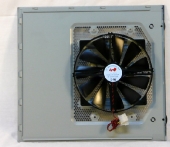Interior
The In-Win Griffin is tailored to gamers as well as the budget consumer alike. Unlike many cases within this price range, there are tool-less hard drive and DVD player bays, which aid in making the overall build process simpler. The only problem with the tool-less design is that the connectors seem a bit flimsy and there are only two for the DVD bays as well as three for the hard drive bays, which means if you need any more than two of either device, you will need to screw them into the case. Overall though, the inclusion of the tool-less features is a nice touch and is still mostly seen in the higher-end cases, such as the NZXT Phantom. The Griffin can fit up to 11” graphics cards, which makes expanding to larger and more powerful graphics cards much easier. There is again a caveat with this, however. The method in which the hard drives are installed allows for them to stick out much further into the case than other installation methods. If you turn the hard drives around, however, you can then install both hard drives and graphics in any slot and not run into conflicts with graphics card lengths.
 |
 |
The side panel includes a 220 mm fan, which takes up most of the panel itself. This will allow for an abundance of fresh air to enter the case directly onto the CPU cooler and the graphics card. The size of the fan is an issue if you are using a large tower cooler as the two will conflict. If this is an issue for you, there is an option of removing the large fan and installing two 120 mm fans in its place, which will work better for tower coolers. The rear exhaust fan is a 90 mm fan, which is rather odd considering the size of the side fan. For people that choose to use coolers such as the Corsair H70 or liquid cooling with 120 mm radiators, there are no places for the radiators to take in the rear of the case, which means that an aftermarket air cooler or the stock CPU cooler are the only options.
As far as the power supply goes, the mounting position is in the top of the case, which is slightly unusual with cases that have been released recently. Most cases have the power supply mounted on the bottom of the case, with a cutout on the bottom so that the power supply can get its own fresh air and not disrupt the general airflow of the case. There is a benefit from having the power supply up top, however. Since most have a 120 mm fan attached, it can be used as another method to exhaust air from the case. Depending on how hot the case gets under load, this can be a very effective way to let air out of the case or it could end up damaging the power supply if the air is excessively hot. Concerning the power supply, this case is not cable-managing friendly. By having minimal places for stowing the unused cables, the case airflow is not necessarily the greatest if you use a non-modular power supply. Even with modular power supplies, getting the cables placed in such a way to keep the air flow uninterrupted is still a challenge. To help increase air flow, you could always install a 60, 92, or 120 mm fan in the front of the case as well, which will help to force air through the front to the rear of the case. The actual build quality is really nice and the case does not seem flimsy. It is exceptionally light and would make a great case for a LAN box. It would have been nice if the inside of the case were painted black as the outside of the case as this would certainly be much different than other cases within this price range.

[…] In-Win Griffin Case Review @ TechwareLabs […]
[…] Reviews Antec LanBoy Air Case Review @ Hi Tech Legion In Win Dragon Rider Full Tower @ Pro-Clockers In-Win Griffin Case Review @ […]
[…] TechwareLabs Review: In-Win Griffin Case Review […]